15 Perfect Plants For An East-Facing Window
Written by Ivy
Nov 10 2022
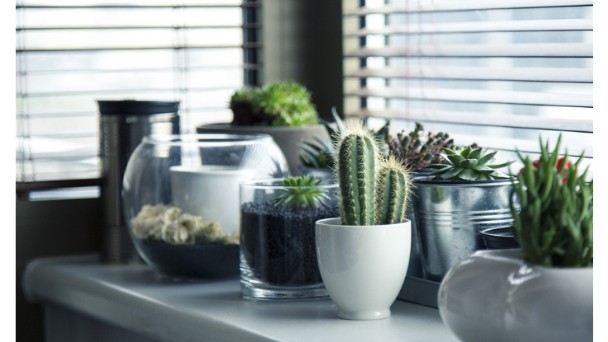
Both east- and west-facing windows are suitable for a variety of fascinating and fascinating indoor plants.
In this article, we discuss the light exposure available in east and west windows and share some suggestions for the types of plants best suited for these locations.
What to Do With An East-Facing Window
Imagine a window facing east as being similar to a window facing north. The east side receives significantly more morning sunlight than the north side, both in terms of direct and indirect light.
Thus, plants placed in windows that face east are likely to develop into robust, healthy plants.
The fact that east-facing windows are frequently quite small presents a problem for many people.
On the east-facing sides of houses and buildings, architects frequently place smaller windows. This could mean that in order to fit smaller plants in specific tight spaces, you'll need to be a little creative.
Naturally, you can choose larger plant specimens if your east window is large.
The opportunity to assemble a plant collection that complements the outdoor landscape plants is provided by a sizable east-facing window.
In windows, hanging plants are almost always a good idea. However, if your windows are small, a large hanging plant may completely block your view.
It is ideal to be able to see the plant and the outside world.
What Are Some Choices for East-Facing Window Plants?
With an east-facing window, consider the climate.
Typically, a home's east side has a slightly cooler temperature than its west side. You should choose your plants accordingly.
Here are some of the top choices in shelf, tabletop or windowsill plants for this challenging location:
1. Calathea
2. Areca Palm (Dypsis Lutescens)
3. Umbrella Tree (Schefflera)
4. Prayer Plant (Maranta)
5. Swiss Cheese Plant (Monstera Deliciosai)
6. Flamingo Flower (Anthurium)
7. Fiddle Leaf Fig (Ficus Lyrata)
8. Hoya Plant (Hoya Carnosa)
9. Jade Plant
10. Peace Lily
11. Boston Fern
12. Nerve Plant
13. Campanula (Bellflower)
14. Asplenium (Bird Nest Fern)
15. Cyclamen Plants
1. Calathea
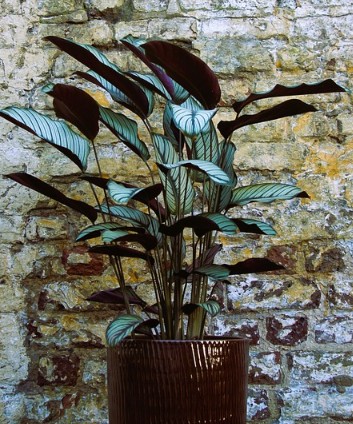
Calatheas thrive in bright, indirect light and are excellent east-facing window plants. They dislike direct sunlight. Regular watering is their favorite, and the soil rarely becomes overly soggy. In humid environments, they do incredibly well.
Outside in tropical settings, calatheas are common, but they cannot withstand cold temperatures. In other places, they are therefore typically grown as indoor houseplants all year long. Furthermore, because they are known for being somewhat picky about their growing conditions, calatheas can be challenging to take care of. On the other hand, when those conditions are met, they grow rather quickly, frequently reaching their full size in a year. Spring is the ideal time to plant them.
2. Areca Palm (Dypsis Lutescens)
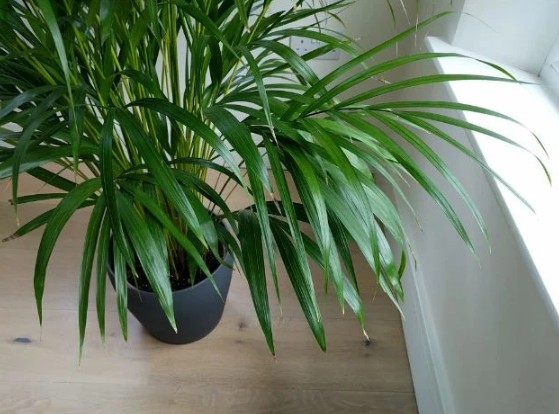
They are very easy to recognize thanks to their long, feathery fronds, but to stay healthy, they require bright, indirect light. Areca palms are ideal for windows that face east or west, therefore. Although they can tolerate lower levels, creeca palms prefer high humidity. A sign that a leaf needs more moisture is browning.
Because areca palm houseplants are quite expensive when fully grown, they are typically bought as small, tabletop plants. They increase the measurement by 6 to 10 inches (15 to 25 cm).) of growth per year until they reach a mature height of 6 or 7 feet (1.8 or 2.1 m.). The areca palm is one of the few palms that can withstand trimming without suffering serious consequences, allowing mature plants to be kept indoors for their entire lifespan of up to 10 years.
3. Umbrella Tree (Schefflera)
.jpg)
The umbrella tree thrives in an eastern exposure because it needs bright, filtered sunlight in the morning but should be protected from the afternoon sun's harsh rays. If these east window plants don't get enough light, they become floppy.
Although umbrella plants thrive in bright, indirect light, they can usually tolerate direct indoor light and only grow more slowly and leggily in medium- to low-light conditions. In general, humidity is not a problem, but if the air is too dry, pests like scale and spider mites may be more likely to infest the plants.
55°F to 75°F (13°C to 24°C) is the ideal temperature range for umbrella plants indoors. In USDA zones 10-11, they can be grown outdoors all year long. Check local regulations before planting outdoors because Schefflera actinophylla is a vigorous grower and is regarded as an invasive species in Florida and Hawaii.
4. Prayer Plant (Maranta)
.jpg)
The prayer plant is indigenous to a region of the jungle that experiences dappled or partially shaded light. Therefore, prayer plants are ideal for windows facing east or west.
Bartolomeo Maranta, a botanist and physician, gave the prayer plant (Maranta leuconeura), which is indigenous to South America and is most commonly found in Brazil, its name. This low-maintenance plant is known for its flat, colorful leaves that fold up at night to resemble hands clasped in prayer. It is a member of the Marantaceae family. Prayer plants are attractive houseplants all year round, but especially during the chilly winter months because they can be grown indoors all year.
High humidity, low light levels (partially to completely in the shade), and moist but well-draining soil are ideal for prayer plants. Although infrequently when grown indoors, they do produce blooms in the early spring. Prayer plants, also known as calatheas (a related plant), are only hardy outdoors in USDA Hardiness Zones 11–12. Their growing season is from early spring to fall.
5. Swiss Cheese Plant (Monstera Deliciosai)
.jpg)
Place it close to an east-facing window where it will receive some gentle morning sun because this tropical plant thrives in warm, indirect light and warm temperatures.
The plant category, or genus, is called Monstera, but several different species of Monstera go by the same common name of "Swiss cheese plant." Generally, Monstera deliciosa is what you'll find, and it has long-lobed leaves with elongated holes (although young leaves might not have these holes). Monstera epipremnoides, a similar-looking plant, has leaves that are almost identical to those of the previous one but have long slashes along the edges instead of holes. Also, the Monstera adansonii has leaves with holes in the shape of hearts. Any species you purchase will be a beautiful, low-maintenance plant with similar requirements.
6. Flamingo Flower (Anthurium)
.jpg)
They have a reputation for being challenging, but the light from an east-facing window is the secret to this South American beauty. Anthuriums have gorgeously textured, distinctive leaves, but they are sensitive to direct sunlight.
This magnificent tropical plant is native to South American regions and has shiny, dark-green, heart-shaped leaves. A continuous display of vivid waxy red, heart-shaped spathes with yellow spadices complements flamingo flowers. The flower endures for a full two to three months, on average. These houseplants thrive best in indirect, high light sources, such as a southern exposure, because that is how they would naturally grow in their native rainforest habitat. For them to bloom, they require this level of light. Although this medium care plant needs a little more care, the overall benefits are worth the work because of how stunning it is.
7. Fiddle Leaf Fig (Ficus Lyrata)
.jpg)
From Sierra Leone to Cameroon, where this plant originally came from, the lowland climate is hot and humid, with frequent but light rain and sun-dried moisture. Place your fiddle in bright indirect light with sporadic full sun exposure to mimic these conditions. Put it in a window, as opposed to next to or a few feet from one, for example.
Just like other plants, the fiddle uses the energy from the sun to fuel its cells. It will require more sunlight than you would typically give a plant because its leaves are enormous in comparison to most other plants. Drooping leaves are an indication that it needs more light if you're not sure if you're providing it with enough.
8. Hoya Plant (Hoya Carnosa)
.jpg)
Grow hoya plant in a bright, airy location away from any exposure to direct sunlight. The best location is a window that faces east, where there is sufficient light but no afternoon sun.
Hoyas are prized for their incredible waxy blooms and their capacity to produce those blooms in low light. Depending on the species, the flowers bloom in tiny clusters and are either pink or white. Some species' flower clusters can contain up to 70 tiny flowers.
The petals of some flowers have a fluffy texture, while those of other flowers have a glossy sheen. They also produce a sweet nectar from the flowers, which when grown indoors are known to drip nectar on shelves and floors. Place these plants somewhere that you don't mind getting sticky, like on top of a surface.
These flowers, however, have more to offer than just their attractiveness. Additionally, they give off an alluring scent that quickly fills a room, which is strongest at night. Some species have been said to smell like vanilla, while others smell like chocolate, honey, or lemon cakes.
Not all, though, are given such a favorable description. Many Hoyas are well known for their unpleasant scent. However, because these smells are strongest at night, they are also simple to avoid. Phrases like "burning rubber" or "off vegetables" don't inspire confidence. On the first day of blooming, the aroma is typically the strongest; as the flowers wilt, it becomes softer.
9. Jade Plant
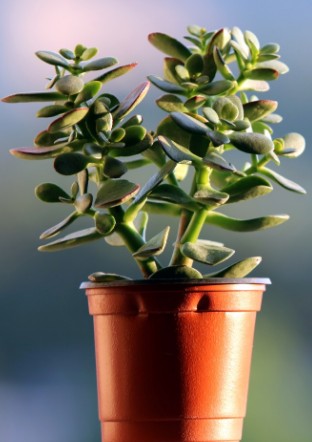
They need to be in a bright spot in your east facing window to get sufficient morning sun. They thrive in windows with a west or south orientation because they are a fairly adaptable plant. The stems of jade plants resemble small tree trunks and they have smooth leaves and thick stems.
The jade plant is a common succulent houseplant with fleshy, oval leaves and thick, woody stems that resemble tiny tree trunks. It grows slowly, gaining only about 2 inches per year, and with a little attention, can reach heights of between 3 and 6 feet.
The jade plant, which is indigenous to South Africa, is frequently given as a housewarming gift because it is believed to bring its owners luck, wealth, and prosperity. The money plant is one of their nicknames as a result.
Jade plants can be brought home or started at any time, either from a nursery or through propagation. They are typically grown indoors because outdoors they need a hot climate. The location of a jade plant in a home should be considered if the owner has pets. Cats and dogs cannot handle the plant in any way.
10. Peace Lily
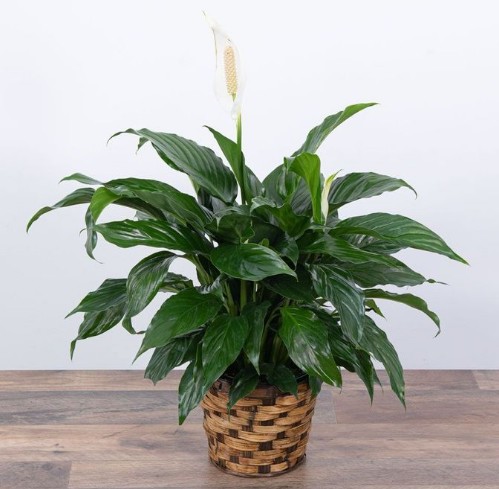
Peace lilies love shade, so it will do well in a room with a north or west-facing window, but don't put it right by the window.
Because they can thrive in partial or full shade, peace lilies are a good choice for low-light areas. If you want a plant friend to brighten up your desk at work, peace lilies are a good choice because they can tolerate fluorescent lighting.
Peace lilies prefer a constant temperature of 65 to 80 degrees Fahrenheit. Keep your plant away from chilly drafts and other extreme temperature changes. So perhaps don't put yours by a door that leads out into the chilly winter air.
11. Boston Fern
Boston ferns are perfect plants for your east facing window. Even just for the lovely plant texture, these evergreen beauties are worth a try. The Boston fern looks fantastic as a hanging plant in your collection of windowsill plants.
Boston ferns thrive best in a lot of indirect light because of their dappled shade native habitat. They do best at the lower end of that temperature range, so you should try to keep yours in the coolest part of your home. They prefer standard room temperature, 55 to 75°F (13 to 24°C).
Boston ferns enjoy humidity, but they don't do well in the typical 10 to 15% humidity of most homes, which is far below the 50% or higher humidity that these plants require. Solutions include keeping your fern in a steamy bathroom, setting it on a pebble tray filled with water, using a humidifier, and/or misting it every day. Insufficient humidity is indicated by brown leaf tips and yellowing.
12. Nerve Plant
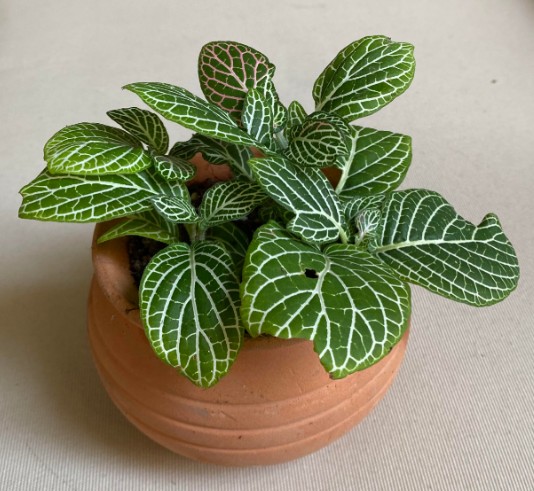
Although they can tolerate slightly lower lighting than many houseplants, nerve plants thrive in direct, bright light. Displaying them in a north or east-facing windowsill is a great option, or you can keep the plant a few feet from a south or west-facing window.
Fittonia prefers bright, indirect light, such as that coming through a filtered curtain or windows with a north or east facing orientation. Keep this plant out of direct sunlight.
You must enjoy watering your fittonia if you want to care for it. You don't want to develop the habit of waiting until it "faints" or wilts before you water it, even though it will do so when it is even mildly thirsty. Fittonia do not like their soil to become completely dry, but they also do not like it to be completely wet. Instead, a "barely moist" atmosphere is the way to go.
13. Campanula (Bellflower)
.jpg)
Indoors, campanula can be grown in either full sun or partial shade. A window facing south should not receive direct sunlight.
A genus of bell-shaped flowers with numerous species is called campanula, also known as bellflower. These plants look great combined with other plants that have a cottage garden feel. Learn how to grow campanula so you can add one of these delightful flowering plants to your garden.
The bell-shaped flowers and the soft purple color of the blooms are beautiful. Although they can also be white or other colors besides purple, ours was a light shade of purple.
14. Asplenium (Bird Nest Fern)
.jpg)
Asplenium nidus, also known as bird's nest ferns, is a plant that grows naturally on other plants. Puting Asplenium (Bird Nest Fern) on an east- or north-facing window is ideal.
These ferns are easy to grow, inexpensive to buy, and widely accessible with very few issues. Given that bathrooms and frequently used kitchens frequently have steamy environments, these indoor plants are especially suitable for these spaces.
This is important because a Bird Nest Fern needs some humidity to really thrive indoors, they'll still cope and deal with an average room but for that extra shine and extra large size you'll need to be misting regularly.
15. Cyclamen Plants
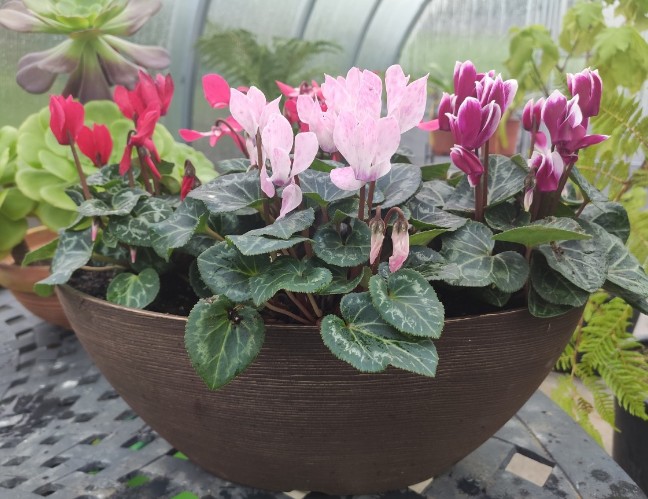
You can place cyclamens in an east-facing window or in a southern exposure that offers bright, indirect light. Cyclamen can be picky when it comes to watering. The soil should ideally get a little dry between waterings without becoming completely wilted.
When grown outdoors, cyclamen require well-drained soil and should be planted in an area that receives plenty of bright indirect light but little direct sunlight. Cyclamen persicum, on the other hand, is typically grown for varieties that are better suited as houseplants; it is related species, such as C. hederifolium, that are more often used when growing cyclamen in the landscape.
The florist's cyclamen, Cyclamen persicum, is typically grown indoors in pots. It goes into dormancy for the summer, but with the right care, it will grow back and bloom in the fall. The conditions for cyclamen's growth determine when it fully enters dormancy. It enters a state of dormancy in response to warm temperatures, but if you maintain a cool environment inside your house, your plant might not seem to do so. Alternatively, it may simply lose a few leaves and not look its best or bloom for a few months.
Plants for West Facing Windows – What to Do
South-facing windows and windows with a west orientation are very similar. West-facing windows may experience intense direct sunlight and warm temperatures.
Several different types of plants may be harmed by the heat and lighting in this situation.
You should cover the plants in your west window to protect them from the sun's rays because of this. In the afternoon, this is especially true.
Less hardy plants' leaves will definitely burn if left unprotected. In fact, some succulents and cacti growing in windowsills will suffer from the intensity of direct sunlight passing through glass.
Fortunately, doing this is not too difficult. To shield your plants from the sun's intense rays, simply hang a sheer curtain that you can pull across the window.
You might only need to do this to lessen the harsh sun's rays and the sweltering temperatures they bring.
Consider external blinds for more efficient shading if you have a large window. West-facing windows should also have deciduous trees planted outside of them.
Because architects typically work to create buildings that maximize natural light, small west windows are uncommon.
The passive solar needs of a large west window are great, and it may offer a beautiful view, but it can be quite harsh on indoor plants.
Choosing West Facing Window Plants
It might seem challenging to build exterior shading for a west-facing window; instead, stick with indoor plants that do well in a hot, sunny environment.
Cacti immediately come to mind. In particularly cold climates, a collection of desert cactus on a windowsill can create a very exotic and captivating display.
Pick plants that look lovely in strong lighting and on bold displays for this environment.
Your window will have exciting contrast and interest when you choose plants with strong architectural structures.
Of course, many hanging plants will thrive in a sizable west window, and this can create a lovely view both inside and outside.
Other Considerations for East and West Facing Window Plant Selection and Care
When selecting plants for your east or west-facing windows, keep the following in mind.
Think About What is Outside
Consider how the trees, buildings, water, and other features appear from your window. Make sure to select plants that will improve your view rather than block it.
Think About What You Have Inside the Window
If you're worried about privacy, you may already have thick drapes or another window treatment that makes it difficult to maintain plants.
To accommodate your plants' need for light, think about how much you are willing or unwilling to change the window coverings currently in place.
How Clean Are Your Windows?
You might not do well with houseplants if your windows have a tendency to get dirty.
Similar to how leaves become dirty, when dirt accumulates on windows, less light is naturally available for plants.
Are you prepared to maintain spotless windows for your plants?
If not, you might want to pick darker-green plants, such as bathroom plants, if your west-facing window allows for it.
Pay Attention to Your Plants' Surroundings
Look at the hues of the room's walls, tabletop surfaces, and other furnishings.
The amount of light surrounding your plants can be significantly increased by using very bright white walls or reflective surfaces. This might be advantageous or detrimental.
To provide your plants with a healthy environment, take stock of the furniture and accents in the space and make any necessary adjustments.
Know the Warning Signs of Improper Lighting
The effects of excessive light can include leaves that curl, wilt, fade, or even scorch and turn brown.
New leaves may be very small if the leaves receive too much light. On the other hand, if plants receive insufficient light, their leaves may become oversized and discolored.
The leaves may turn strangely variegated, yellow, or pale. Plants that are starving for light may stoop or bend toward the window, grow stunted, lose leaves, and fail to bloom.
Keep an eye on your plants and keep track of any changes or unusual circumstances because these issues can take some time to manifest.
Latest Updated
- Benefits of Bugleweed - 7 Science-backed Health Benefits
- Bugleweed Dangers & Side Effects - Is It Poisonous?
- How to Plant Evergreen Trees - What You Should Know
- When to Plant Evergreens - Grow Guide for Evergreen Trees
- 12 Wonderful Evergreen Shrubs for Your Garden
- 12 Popular Evergreen Plants with Pictures for Beginners
- When And How To Prune A Lilac Bush Like a Pro
- How to Grow & Care for Lilac Vine (Hardenbergia Violacea)
- Japanese Lilac Tree (Syringa Reticulata) Care & Propagation Guide
- Shumard Oak Pros and Cons - What to Know
Popular Articles
- Winter maintenance of Antirrhinum Majus
- How to Grow Terminalia Mantaly Tree
- How to Grow and Care for Crossostephium Chinense
- How to grow Antirrhinum Majus in spring
- Peristeria Elata (Dove Orchid) Profile: Info & Care Guide
- Underwatered Snake Plant (Sansevieria Trifasciata) - Signs And How To Fix
- How to Care for Brazilian Jasmine Plant (Mandevilla Sanderi)
- How to Grow & Care for Graptopetalum Purple Delight in Summer
- Rosa Chinensis (China Rose): Plant Growing & Care Tips
- How to Care for Baby Sun Rose (Aptenia Cordifolia)